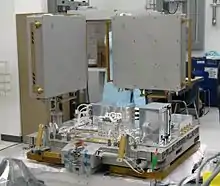SpaceCube
SpaceCube is a family of high-performance reconfigurable systems designed for spaceflight applications requiring on-board processing. The SpaceCube was developed by engineers at the NASA Goddard Space Flight Center.[1] The SpaceCube 1.0 system is based on Xilinx's Virtex-4 commercial FPGAs. The debut mission of the SpaceCube 1.0, Hubble Servicing Mission 4, was the first time Xilinx's Virtex-4 FPGAs flew in space.[2]

The Hubble Space Telescope being lifted out of the payload bay of Atlantis before being released back into space.

SpaceCube aboard MISSE-7
Missions
- Hubble Servicing Mission 4: The SpaceCube was the brains of the Relative Navigation Sensors autonomous docking experiment that was intended to run in parallel with the astronaut controlled docking of the Hubble Space Telescope.[3] RNS met its stated goals.[4]
- MISSE-7: The SpaceCube was attached to the outside of the ISS during an EVA on Space Shuttle Mission STS-129 (Nov 2009). It provides an on-orbit test platform for demonstrating innovative radiation hardened by software techniques. It is mounted on the NRL's MISSE7 experiment which is attach to an ExPRESS Logistics Carrier.[5][6]
Family overview
- SpaceCube 1.0: Based on Xilinx's Virtex-4 commercial FPGAs.
- SpaceCube 1.5: Intermediate version of SpaceCube 2.0. Based on Xilinx's Virtex-5 commercial FPGAs. Scheduled to fly on sounding rocket flight in the fall of 2010.[7]
- SpaceCube 2.0: Currently under development with over $1 million in funding.[7] The SpaceCube 2.0 system is based around Xilinx's new radiation-hardened Virtex-5 FPGA.[7][8]
Awards
NASA's Goddard Space Flight Center SpaceCube team earned an honorable mention for the 2009 "IRAD Innovator of the Year" award.[9]
On-board science data processing achievements
- Synthetic Aperture Radar (SAR) results:
References
- Office of the Chief Technologist (2006). "NASA Goddard Space Flight Center FY 2006 Internal Research and Development Program" (PDF). NASA Goddard Space Flight Center.
- "Xilinx December 2008 Newsletter". Xilinx. 2008.
- Office of the Chief Technologist (2008). "SpaceCube to Debut in Flight Demonstration: Hybrid Computer to Fly on Hubble Servicing Mission". NASA Goddard Space Flight Center.
- Flight Results of the HST SM4 Relative Navigation Sensor System
- ISS Program Scientist's Office (2009). "Materials International Space Station Experiment - 7 (MISSE-7)". NASA. Archived from the original on 2008-12-10.
- Astronauts Install SpaceCube on International Space Station
- Office of the Chief Technologist (2009). "Goddard Tech Trends Spring 2009" (PDF). Goddard Space Flight Center.
- "Rad-Hard Virtex-5". Defense Update.
- "Goddard 2009 IRAD Innovator of the Year award". Goddard Space Flight Center. 2009.
- "SpaceCube On-Board SAR Data Processing Results". Goddard Space Flight Center. 2010.
External links
- PowerPC405 MIPS Study
- Goddard Space Flight Center technologies site
- SpaceCube on Facebook
- A pose and position measurement system for the Hubble Space Telescope servicing mission
- Relative Navigation
- Summer 2008 Goddard Tech Trends
- MAPLD 2009 RNS SpaceCube
- MAPLD 2009 SpaceCube Activities
- RHBD Xilinx Virtex-5
- Heavy ion SEE test of Xilinx Virtex4 XC4VFX60 FPGA
- SpaceCube Virtex-4 FPGA qualification methodology
- Spring 2009 Goddard News Tech Transfer
- Xilinx XCell Journal Customer Innovation Issue
- Media
- SpaceCube Photo Gallery on Flickr
- MISSE-7 SpaceCube development team
- SpaceCube in Atlantis Shuttle bay(The SpaceCube is mounted on the MISSE-7 ExPA on ELC-2 on the bottom right.)
- SpaceCube mounted to MISSE7's ExPA(The SpaceCube is the smaller box with several connectors on top)
- Naval Research Lab's MISSE-7 Press Release
This article is issued from Wikipedia. The text is licensed under Creative Commons - Attribution - Sharealike. Additional terms may apply for the media files.